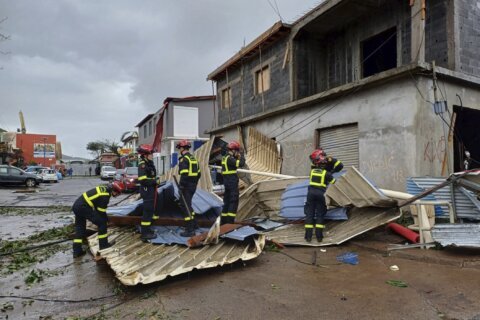Amid an alarming rise in hate crimes in the United States in recent years has come a rise in antisemitism — hostility or discrimination directed against Jewish people — and antisemitic attacks. Educators can play an important role in teaching students about antisemitism, helping them make sense of events globally and in their own community.
What Is Antisemitism?
As part of his role as the liaison to Jewish communities for the New York City Commission on Human Rights, Jonah Boyarin facilitates workshops on antisemitism for students and educators. In the organization’s training, antisemitism is explained as “being based on two lies about Jewish people,” he says.
“So the first set of lies are what we call common stories or conspiracy theories about Jewish people that falsely imagined Jewish people as being in control of banks, the media, Hollywood, the entire economy, etc,” he says. The second “is a set of dehumanizing lies about Jewish people, saying that Jewish people don’t belong here. That they’re not like us and can’t be trusted.”
Those lies work together, he says, “because you’re more likely to believe a fantastical conspiratorial story about a group of people if you don’t think that they’re just everyday people.”
In schools, teaching about antisemitism can include lessons on the definition and history of antisemitism, as well as modern-day examples and how to intervene (what educators call being an “upstander”).
Why Should Schools Teach About Antisemitism?
With the recent rise in antisemitic incidents, educators need to be prepared to help students understand current events as well as history. After the 2018 Pittsburgh synagogue attack, for example, in which a gunman who had made antisemitic posts online killed 11 people and wounded six during services, students had questions that educators needed support to answer, says Nick Haberman, founder of the LIGHT Education Initiative, a program that provides human rights education to schools. “And it’s not, ‘Why did the Holocaust happen?'” Haberman says of students’ questions. “It’s, ‘Why did somebody shoot up a synagogue? What is happening here?'”
Peter Strand, who like Haberman is a former teaching fellow at the U.S. Holocaust Memorial Museum, says he encountered a wave of questions from his fifth graders at Irving Elementary School in Bozeman, Montana, after neo-Nazis blanketed his community with racist and antisemitic fliers.
Teaching about antisemitism is also a central component of making schools safe and inclusive spaces for all students. “Any form of discrimination, marginalization, identity-based violence is bad for your school district,” Haberman explains. “And it’s ultimately bad for the learning environment.”
[Read: How to Handle Bullying at School.]
Conversations about antisemitism can be connected to broader ideas about systemic inequality and prejudice. “When we look at the history of antisemitism, it is a history of people blaming Jews for problems,” says Noah Schoen, an antisemitism educator and co-founder of “Meanings of October 27,” an oral history project about the Pittsburgh synagogue shooting. “I think the conversation about antisemitism is an incredibly valuable entry point into a conversation about blame and responsibility in our society. And ultimately, we want to be teaching young people to take responsibility for problems that we face in our world and not blame others.”
Boyarin highlights the importance of “equipping students with the critical thinking to understand what are the historical, economic, social, political conditions that have created the society we have today.” This empowers students to understand systemic causes of inequality, he says.
Using Stories to Teach About Antisemitism
Experts say that before teaching about antisemitism, educators need to develop their own understanding of the subject. Both Haberman and Strand recommend the guidelines set forth by the United States Holocaust Memorial Museum for teaching about the Holocaust, which they say are applicable to antisemitism education generally as well as other complex topics.
Literature and real-life stories can be powerful tools, experts say. “I think stories are really important,” Schoen says. “One of the most effective ways that Jews have educated non-Jews about antisemitism is through the stories of Holocaust survivors, not saying, ‘These are the facts. This is what happened. This is the history,’ but … survivors saying, ‘This is my story.”
Boyarin also emphasizes the value of presenting diverse stories from the Jewish community as a way to combat stereotypes. “There’s not just one way to look as a Jewish person,” he says. “Jewish people are our neighbors in all different kinds of ways and look all kinds of ways.”
When Should Students Learn About Antisemitism?
Experts say many people equate antisemitism education with conversations about graphic violence. But it’s possible to introduce conversations about antisemitism thoughtfully from an early age.
“A big principle in Holocaust education these days is “gently in and gently out,” Schoen says. “The cutting edge of Holocaust education today is to present the content in a way that is trauma-informed so that students can grapple with it on their level.”
Having conversations about antisemitism is in fact especially important with younger students. The internet and social media are powerful drivers of youth radicalization. That’s why “the best time to prevent radicalization and extremism and hate from growing in young people is in pre-adolescence” Haberman says.
Teachers and parents can look for age-appropriate resources, like this guide from the USC Shoah Foundation in partnership with Nickelodeon.
With young children, educators can use read-alouds to introduce students to Jewish stories or spark conversations about inclusion. Educators can also focus on more general social-emotional skills, teaching about values like kindness, compassion, love, tolerance, empathy, equity and inclusion, Haberman says.
Once kids reach upper elementary school, they can engage in conversations that introduce more historical detail and context, and talk about how to be an upstander, and intervene when someone is being bullied or attacked, rather than being a bystander. In middle school and beyond, students can learn about more sensitive topics related to antisemitism and the Holocaust. This does not require displaying disturbing content in the classroom. “The best Holocaust education I’ve seen involves no graphic content whatsoever,” Haberman emphasizes.
What Are the Challenges?
Some of the biggest challenges to teaching about antisemitism are structural. As teachers are under pressure to help students recover from pandemic-related learning gaps, they’ve also faced an increasingly hostile political climate in many states, in particular Republican-led bans on classroom conversations around race and inequality.
“A lot of people around me are definitely feeling the pressure that they’ve just got to follow things by the letter, because they don’t want to get (attacked),” says Strand.
[READ: Teaching Civics After Jan. 6.]
Another structural challenge is the lack of funding and support for social studies and civic education. The U.S. spends roughly five cents per student per year on civic education, “a mere 1% of what we spend per year on STEM,” according to the civics education initiative Educating for American Democracy.
At least 20 states require some form of Holocaust education, according to the Holocaust Memorial Museum, which can range from observing Holocaust Remembrance Week to providing suggested readings. Generally, students learn about the Holocaust in secondary social studies courses. However, most curricula do not require education about antisemitism more broadly.
This means a lot of educators come to antisemitism discussions unprepared. “I didn’t realize that antisemitism didn’t start and end with Hitler,” Haberman says. “I didn’t know because I had never studied it that antisemitism was thousands of years old and there’s all these different forms and stages and eras, and contemporary antisemitism is a very real problem.”
In spite of these challenges, Strand calls teaching about antisemitism “the most rewarding and consequential work.”
“One of the things I have learned in my study of the history of antisemitism is that oftentimes, the difference between an antisemitic sentiment turning into a calamity versus being averted is not just the actions of Jews, but the actions of non-Jews,” Schoen says. “When other non-Jews stand up against antisemitism, it may exist, it may be out there, but it’s not allowed to foment.”
More from U.S. News
How Schools Are Improving STEM Education for Girls, Students of Color
How Schools Contribute to Negative Body Image in Kids
What to Know About Cyberbullying
How to Teach Young People About Antisemitism originally appeared on usnews.com







